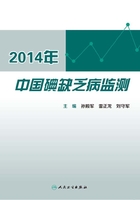
上QQ阅读APP看书,第一时间看更新
2014年山西省碘缺乏病病情监测结果报告
■ 王永平 贾清珍 王三祥 张向东 郭百锁 张峰峰 王正辉
李 军 程晓天 吴赵明 任艳婷 陈红云 郭俊敏
(山西省地方病防治研究所)
摘要
目的 掌握山西省居民在食盐加碘浓度调整以后的碘缺乏病病情及碘营养现状;评估山西省居民在盐碘浓度调整以后碘营养改善效果。
方法 在山西省范围内,按“人口比例概率抽样方法(PPS法)”确定30个县(市、区),采取单纯随机抽样方法从每个抽样单位中抽取1所小学;在被抽中的小学随机抽取50名8~10岁儿童,进行甲状腺容积、尿碘及盐碘测定。在每个抽取小学所在乡(镇、街道办事处),抽样20名孕妇,进行尿碘含量测定。对比2011年盐碘浓度调整前的历史资料,评估山西省盐碘浓度调整效果。
结果 全省共检测居民食用盐1437份,盐碘中位数为24.1mg/kg,碘盐覆盖率为95.4%,合格碘盐食用率为76.6%;共检测儿童尿碘1496份、孕妇尿碘630份,尿碘中位数分别为224.6μg/L、177.1μg/L,均明显低于2011年(274.6μg/L、279.6μg/L)( H=70.1, P﹤ 0.0001; H=153.5, P﹤0.0001)。儿童及孕妇处于碘营养适宜区间的调查点所占的比例分别为36.7%(11/30)、56.7%(17/30),均高于2011年的6.5%(2/31)、25.8%(8/31)( χ 2=7.88, P=0.004; χ 2=5.0, P=0.025);共检查8~10岁儿童甲状腺1552人,甲状腺肿大69人,肿大率为4.4%。
结论 新标准浓度碘盐能够保证山西省碘缺乏病处于持续消除状态,而且使学龄儿童为代表的一般人群及孕妇等重点人群碘营养更加合理。
ABSTRACT Objective To master the iodine nutrition status of residents after salt iodine concentration was declined in Shanxi Province, and to evaluate the effect of iodine nutrition improvement of residents after the adjustment of salt iodine concentration.Methods According to the proportionate to population size sampling, 30 county-level monitoring sites were selected, a primary school and a town were selected from each county (city, district) by simple random sampling method and fifty students aged 8-10 were selected in each school, thyroids of these students were examined and their household salt iodine content and urinary iodine content were determined;20 pregnant women were randomly selected from each town and urinary iodine content were determined, all results were compared with the results of the 2011 to evaluate the effect of iodine nutrition improvement of residents after the adjustment of salt iodine concentration. Results The median ofsaltiodine concentration was 24.1mg/kg, the coverage rate of iodized salt was 95.4%, and the rate of qualified iodized salt was 76.6%;the median of urinary iodine of children and pregnant women was 224.6μg/L and 177.1μg/L respectively, which were significantly lower than that of 2011 (274.6μg/L, 279.6μg/L) ( H=70.1, P ﹤0.0001; H=153.5, P﹤0.0001).The proportion of counties which iodine nutrition of children and pregnant women in suitable range was 36.7% (11/30)and 56.7% (17/30),which were higher than that of 2011 [6.5% (2/31),25.8% (8/31)], and the goiter rate of children was 4.4% (69/1552). Conclusions The new standard of iodine concentration in salt can ensure that the sustained elimination of iodine deficiency disorders in Shanxi Province, and it can improve the iodine nutrition of children aged 8-10 years and pregnant women to more reasonable.
2012年3月15日起,根据国家“因地制宜、分类指导、科学补碘”的方针,国家盐碘浓度开始执行新的标准(GB 26878—2011),新标准规定了三个层次,即20 mg/kg、25 mg/kg、30 mg/kg三个层次,允许波动范围为±30%。山西省结合防治实际情况,将合格碘盐浓度由20~50mg/kg下调为18~33mg/kg,目的是在确保持续消除碘缺乏病的基础上,追求不同人群的碘营养适宜状态。山西食盐加碘浓度调整后,强化了盐碘监测,但因为新碘盐的普及需要一个过渡期,调整以后普通人群及孕妇等重点人群的碘营养状态尚未做过全面的调查。2014年9月,为掌握山西省居民在食盐加碘浓度调整以后的碘营养现状,评估盐碘浓度调整以后居民碘营养改善效果,山西省地方病防治研究所根据国家《碘缺乏病监测方案》的要求,开展了全省的碘缺乏病病情监测,现将结果报告如下: